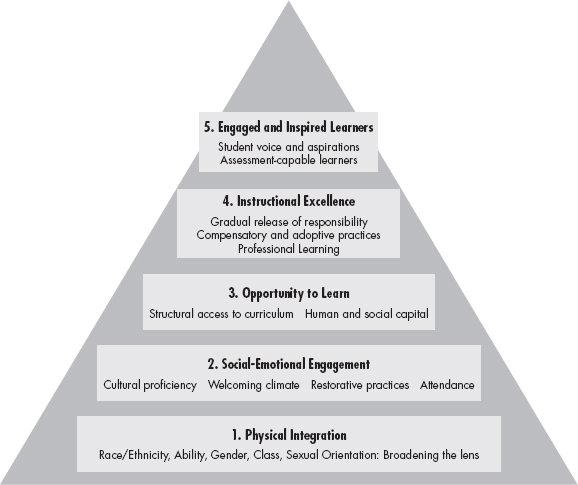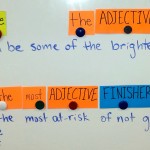It’s that time of year when the child within us develops a dreamy, far-off look, and her eyes begin to gleam. Sugar plums? A Red Ryder BB gun? A new laptop? A roof rack and two kayaks? Creating a holiday wish list delights the imagination.
As I wrote earlier in the fall, our once-traditional junior high is undergoing a transformation. We’ve tossed many of the typical structures which define secondary school, and have instead set out on a journey toward team-based flexible scheduling, personalized education, social-emotional learning and project-based learning. Although we still have administrators, we are largely a teacher-powered school now, and much of our day is structured using Google spreadsheets, ongoing Hangouts chats and the anchoring structures of teams and “advisory” classes, which function like homerooms. The idea is to build strong learning communities, and to find ways to be more responsive to student needs and allow for more student agency.
Trying to fit the requirements of Arizona’s rigid Structured English Immersion model (the notorious “4-Hour Block”) into this type of fluid and dynamic environment has been challenging. I keep hoping for a change in the law that might allow us more flexibility, but only the upcoming legislative session can decide that. For now, all I can do is dream and envision: What would a truly equitable environment look like for our English language learners?
We have worked very hard to support all students in our school, and that work is ongoing, so I won’t comment on which items on my list we have already achieved or planned for. Rather, I will share with you my first thoughts about what a completely equitable program would provide. Warning– I may have practiced “unbridled avarice,” and my list ended up being a long-ish read. I wish for…
- English learners to be integrated into various groups throughout the day, as all other students are, rather than move monolithically as a group throughout their schedule.
- A curriculum and repertoire of social-emotional learning strategies and restorative practices that all educators learn, implement, support and refine throughout the year.
- A diverse, multilingual faculty and staff who share and celebrate our differences even as we learn and celebrate the diversity within our student body.
- Expressive writing, artwork and academic products from a wide variety of students prevalent throughout the building.
- High academic expectations for all students, including English learners.
- Instructional support staff and manageable class sizes to support the individual needs of all students.
- Planning for schoolwide events that includes strategically welcoming and providing for families who do not speak English or who may not understand the expectations and practices of American schooling, including behavior, dress, academic standards, course structures, testing requirements, school-home communication, etc.
- English learners included as student leaders, or at least participants, in schoolwide events and outreach, and maybe even in student government.
- Opportunities for English learners to access high-level curriculum in the content areas. (A large part of providing access is helping them acquire academic language as quickly and efficiently as possible; however, there must be ongoing efforts to ensure that students are also supported in learning math, social studies, science and various elective courses which have a high impact on academic success and future choices, such as fine arts, engineering and industrial arts, business, or other career and technical education courses. Students and families must also understand the sequencing of courses toward advanced high school coursework [prerequisites, sequenced math courses, etc.] and access to these sequences needs to be provided and supported.)
- Quality professional development for all educators to support and differentiate for English learners. A commitment and belief by all educators that these students can learn and express what they know.
- Special education teachers or school psychologists who have the expertise to help educators identify EL students who may have disabilities that could complicate the language acquisition process.
- Grading and assessment policies that allow for differentiation of product for English learners, and are designed to reflect growth and progress, not simply meeting a standards-based goal that was designed for native speakers.
- Time provided for all educators to team around the specific challenges of supporting English learners, and to identify professional learning needs related to this.
- Gradebooks, grading policies, computer systems and a master schedule that has the capacity to accurately reflect an English learner’s day and coursework.
- Procedures for welcoming a newcomer student and quickly integrating him or her academically and socially.
- Ongoing two-way communication between home and school which supports the student both academically and socially-emotionally.
- Partnerships with community organizations and businesses which support our families and enrich our students’ experiences at school.
- Student venues to express hopes, dreams, goals and to develop a plan for personal and academic growth, including choices of coursework.
- No requirement for parents to opt completely in or out of ELD programs (as they now do); parents and students would have the opportunity to work with educators to make decisions about the appropriate amount and levels of language acquisition services.
- A media center collection of books and other resources that reflect diversity of topics, cultures, languages, perspectives, reading levels, genres and styles.
- Students who feel motivated and capable to move up the levels of, and eventually pass, the state AZELLA test; support for students who have recently passed and moved out of ELD courses.
I draw my definition of equity from the work of Dr. Dominique Smith, et al, in the book Building Equity: Policies and Practices to Empower All Learners. Dr. Smith and the other authors have developed a taxonomy to help describe what building equity would look like:

Image Credit: Building Equity: Policies and Practices to Empower All Learners, by Dominique Smith, Nancy Frey, Ian Pumpian and Doug Fisher. Published by ASCD, 2017
What I like about this model is that it is a reminder that equitable treatment of all students goes far beyond the individual teacher and her practice within the classroom; it requires both instructional excellence and a systemic commitment to inclusion and education of every student.
Within our school, we have control over many things on this list; however, for many of the items, change is needed at the district and even the state level before we would have the freedom to make choices in the best interests of our students. I don’t think Santa will be bringing me those items. It’s up to me and other teacher leaders to find ways to advocate for change at all levels.
Other writing by me on the need to change the current policy for English Language Development education in Arizona.










Comments 3
I love the idea of flexibility and problem solving approaches within our control to change the environment. While I understand the government dictation of certain things I agree that it is up to teacher leaders to find ways to step outside the box and do right by students.
… as best we can, for sure! We have nosed our way around every corner or the 4-Hour box and without being out of compliance, or more human resources on campus, there are some very sticky limitations which make certain items on my list pretty impossible. For true equity there has got to be some policy change!
This is an excellent summary of changes that we need throughout our system. Clearly, we need more than the typical quick fixes that our schools adopt and our state supports.